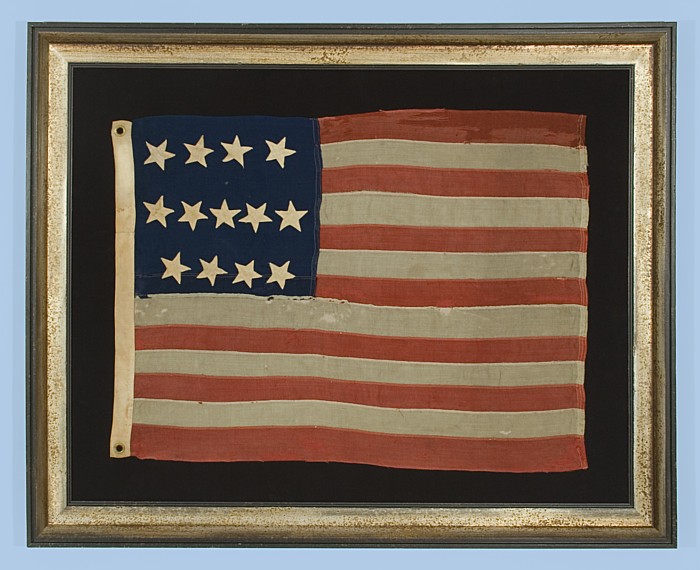
| |
13 STARS, 1890-1900, RARE & UNUSUALLY GRAPHIC 4-5-4 PATTERN |
|
| Available: |
Sold |
| Frame Size (H x L): |
Approx. 36" x 45" |
| Flag Size (H x L): |
26" x 35" |
|
| Description....: |
|
13 star American national flag made in the last decade or of the 19th century. The stars are arranged in rows of 4-5-4, very seldom seen during this period, when 13 star flags more commonly display rows of 3-2-3-2-3, or else a medallion configuration. Also note how the stars point in various directions on their vertical axis, which adds a crude but strong visual element. Note how the flag's nearly square proportions, as well as its well-worn condition, add to its overall presentation.
The canton and stripes of the flag are treadle-sewn of wool bunting. The stars are made of cotton, treadle-sewn, and double-appliqued (applied to both sides of the flag). There is a twill cotton sleeve with two brass grommets. Use of the sewing machine with a straight running (lineal) stitch for the appliqueing of stars is most commonly seen in the five year period from 1890-1895. After that a zigzag machine stitch, less attractive but more practical, was predominantly used. Flags with lineal, treadle-machine-sewn stars were more likely to have been produced in small, cottage industry settings and thus tend to have some of the more crude features that are more common in homemade flags.
13 star flags have been used throughout our Nation's history for a variety of purposes. The U.S. Navy used the 13 star count on small boats, not only in the 18th century, but throughout much or all of the 19th century, particularly the second half. The practice ended in 1916 following an executive order of President Woodrow Wilson. Some private ships also used 13 star flags during the same period as the Navy, and the use of yachting ensigns with a wreath of 13 stars surrounding an anchor, which began in 1848, still persists today. Among other uses, 13 star flags were carried by soldiers during the Mexican and Civil Wars and displayed at patriotic events, including Lafayette's visit in 1825-26, the celebration of the Nation's Centennial in 1876, and the Sesquicentennial in 1926.
Mounting: The flag has been hand-stitched to 100% silk for support on every seam and throughout the star field. Fabric of similar coloration was placed behind the flag for masking purposes. The flag was then hand-sewn to background of 100% cotton twill, black in color. The background fabric has been washed to reduce excess dye. An acid-free agent was added to the wash to further set the dye and the fabric was heat-treated for the same purpose. The mount was then placed in a black-painted and hand-gilded, contemporary Italian molding. The front is u.v. protective plexiglas.
Condition: There are losses throughout the flag from regular use. Approximately 50% of the top stripe is absent and there are smaller losses throughout. Period wool and cotton fabric of similar coloration was placed behind the flag to mask the damage. Many of my clients prefer early flags to show their history of use in this manner. |
|
|
|
| Collector Level: |
Advanced Collectors and the Person with Everything |
|
| Flag Type: |
Sewn flag |
|
| Star Count: |
13 |
|
| Earliest Date of Origin: |
1890 |
|
| Latest Date of Origin: |
1900 |
|
| State/Affiliation: |
13 Original Colonies |
|
| War Association: |
|
|
| Price: |
|
|
| |
Views: 3718 |
|
|
|

